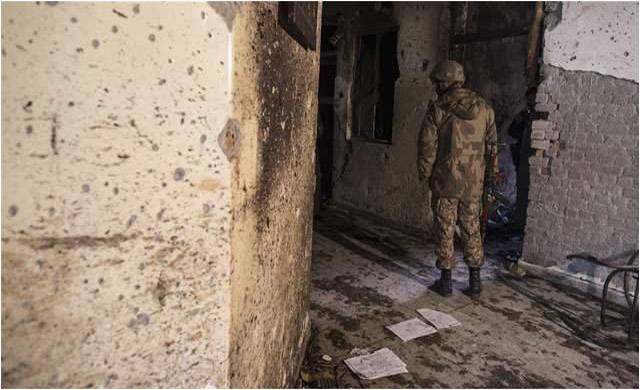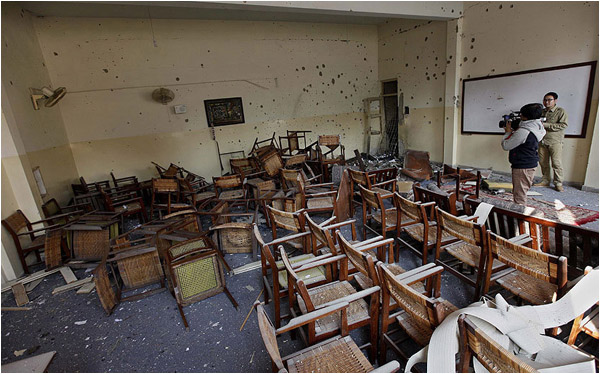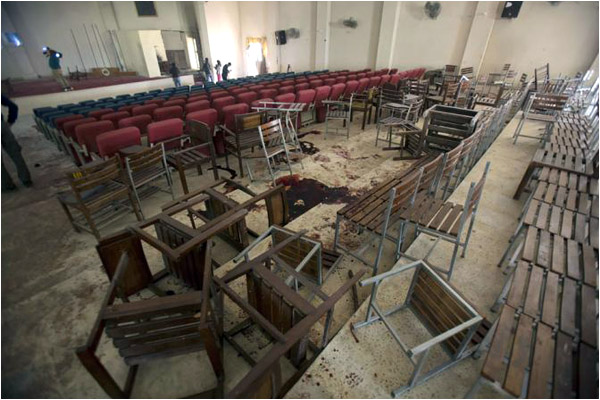
Full many a flower is born to blush unseen
– Thomas Gray
On the cold morning of 16th December, a gruesome act in Peshawar took 150 lives, including 134 children. Visiting the Army Public School 10 days after the mayhem, I could not help being overwhelmed at the sight of grieving visitors that thronged the school lawn – a site of homage to the departed souls. Ahead of the memorial enclosure was the sprawling cricket ground. It is a spacious, very well planned campus, surrounded by military units except on the south eastern side, where there are urban civilian settlements. The shortest route to the school auditorium is from the rear wall adjacent to a small road winding into the urban maze of buildings. There are no military checkposts on that road. At 10:15am on December 16, a group of seven terrorists arrived on a vehicle, and burned it to distract the mobile vigilance teams of the army. As the quick reaction force dashed to the scene, the terrorists scaled the rear wall of the school adjacent to the Toddlers Academy, and made for the auditorium shooting the sentry and the watchman dead.
The school auditorium was full of kids attending a first aid demonstration by a military hospital team. The younger kids from the junior classes sat near the podium while the senior students occupied the rear seats. On hearing gunshots, the doctor conducting the demonstration requested the principal to inquire about the disturbance outside. She went out to see what was happening. Suddenly, gunmen carrying automatic weapons and grenades barged into the auditorium from the back doors and started firing bullets indiscriminately. The doctor and some children ran out from the front entrance. Those who couldn’t flee fell over each other as the bullets hit them. Some lay between the seats on the floors beneath the bodies of their teachers and mates, feeling the stinging bullets piercing their legs, arms and torsos, after piercing the lifeless bodies of their friends and teachers piled above. After firing for a few minutes, the terrorists left the auditorium to look for students in the adjacent science laboratories and computer rooms. Making use of the small interval, some brave kids limped out of the auditorium and were guided towards the secure areas by the brave principal and some staff members.
"In our entire married life, that was the only time she rejected my phone call"
The bestiality continued as the gunmen returned to the auditorium for another round of killings. They sprayed bullets on all those who still moved or showed any signs of life. They threw smoke grenades and white phosphorus grenades to cause more casualties. In one incident, a mother and child who had been hiding were killed when the boy challenged the killers in an emotional outburst. Some communication intercepts revealed the terrorists were being assured by their handlers that the children were old enough to kill. The handlers also told them to engage and kill all army soldiers that came to confront them.
The brave school principal, Mrs Tahira Qazi, was out of harm’s way and could have conveniently escaped, but she stood her ground and kept guiding her students to safety. She was the one who made several calls to army authorities and the parents of the children to come and help in their evacuation. Meanwhile, the army’s quick reaction force had also seen through the maneuver of the burnt vehicle and reached the school to counter the situation. The most courageous response was by Lance Naik Altaf of an engineers battalion, who, on becoming aware of the attack in a nearby military unit, got hold of weapons, reached the school and fired on the gunmen. His courage forced the seven gunmen to concentrate frontally towards the emerging threat little knowing that so far it was a lone courageous soldier. The army and police had meanwhile cordoned off the area while the QRF assessed the situation for a plan of rescue. Lance Naik Altaf’s brave action compelled all terrorists to barricade themselves in the administrative block where 30 students and teachers also lay trapped. The brave soldier was martyred in the exchange of fire.

The dedicated Mrs Qazi continued evacuating children all this while. She declined a phone call by her life partner. “In our long married life, that was the only time she rejected my call,” said her husband Lt Col (r) Zafar. Conspicuous by now, the principal invited the ire of militants, who shot her point blank in her office as they got holed up for the final fight. The militants had laid IEDs and booby traps to defend themselves as the army and commandos cordoned them off and moved closer. The anti-terror unit of Special Services Group arrived at 1:15 pm and stormed the block from three directions at 3:15. In a bloody exchange of fire, 12 SSG personnel, including four officers, sustained injuries, while all seven terrorists were killed or blown up. Of 30 teachers and students trapped in the building, 24 were rescued unharmed.

The 1,100 children of the Toddlers Academy were rescued and handed over safely to their parents by 4pm – no mean achievement in that situation. Had the soldiers not reacted bravely, these young children were sitting ducks. Over 1,000 children also escaped unhurt from the main school and were safely escorted away.
The blood of innocent children has galvanized the nation into a unified counter terrorism response along with denial of space for Taliban apologists. But the lesson that trumps all lessons is the triumph of human spirit in the face of adversity.

